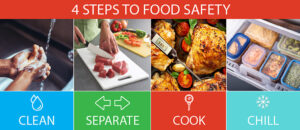Cooking at Home: Keeping You and Your Family Safe
 When it comes to safe food handling, the Center for Disease Control (CDC), has four words for everyone: clean, separate, cook, and chill.
When it comes to safe food handling, the Center for Disease Control (CDC), has four words for everyone: clean, separate, cook, and chill.
Following these four guidelines will ensure you and your family are safe when cooking at home.
Clean
Before and during cooking, take the time to clean your hands and the surfaces in your kitchen. Those germs that cause miserable food poisoning can survive on surfaces and nooks and crannies, allowing them to spread around your kitchen. And you don’t want that!
Wash your hands for at least 20 seconds with soap and water before you start. Take breaks to wash in the middle of preparation and definitely before you eat. Take the same care with utensils, cutting boards, and countertops, using hot, soapy water, or using tools that have been run through a dishwasher. Remember to rinse fresh fruit and vegetables thoroughly before using to reduce germs, too.
Separate
This tip refers to keeping raw meat, poultry, seafood, and eggs away from foods that are ready to eat to prevent spreading bacteria. Don’t use the same cutting board and plate for raw meat, poultry, and seafood that you would use to cut the vegetables for your salad. Keep separation in mind when grocery shopping, too, and place your meat packages in bags to prevent spreading juices to ready-to-eat foods. Raw meat, poultry, seafood, and eggs should also be separated from other foods in the refrigerator.
Cook
To avoid food-borne illnesses, it’s extremely important to cook foods to their correct temperature. According to the CDC, “Food is safely cooked when the internal temperature gets high enough to kill germs that can make you sick. The only way to tell if food is safely cooked is to use a food thermometer. You can’t tell if food is safely cooked by checking its color and temperature.”
For example, whole cuts of beef, pork, veal, and lamb should reach 145° and then rest three minutes before carving or eating. Ground meats, like beef, pork, and turkey, should be cooked to a temp of 160°.
Visit FoodSafety.gov for a complete list of appropriate cooking temperatures.
Chill
Your refrigerator should be set below 40° to prevent food from growing harmful bacteria. Refrigerate perishable food, your leftovers from dinner, within two hours. And take precautions when thawing frozen food. Thaw it in cold water, the refrigerator or the microwaves, not on the counter. The CDC reports “bacteria can multiply quickly in the parts of the food that reach room temperature.”
Keep these tips in mind to serve up healthy meals without risks. Visit the CDC’s website for more information.